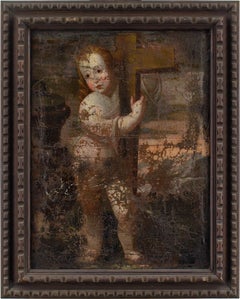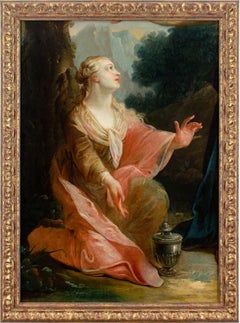Video Loading
Want more images or videos?
Request additional images or videos from the seller
1 of 14
UnknownEarly 18th-Century Spanish School, Christ In The Tombc. 1725
c. 1725
$1,653.27List Price
About the Item
- Creation Year:c. 1725
- Dimensions:Height: 16.5 in (41.91 cm)Width: 28.5 in (72.39 cm)
- Medium:
- Movement & Style:
- Period:
- Condition:Cleaned. Revarnished. Canvas relined. Craquelure throughout. The paint layer is stable. Later stretcher. Frame in excellent condition.
- Gallery Location:Cheltenham, GB
- Reference Number:1stDibs: LU2328216513762
About the Seller
5.0
Platinum Seller
Premium sellers with a 4.7+ rating and 24-hour response times
Established in 2017
1stDibs seller since 2023
245 sales on 1stDibs
Authenticity Guarantee
In the unlikely event there’s an issue with an item’s authenticity, contact us within 1 year for a full refund. DetailsMoney-Back Guarantee
If your item is not as described, is damaged in transit, or does not arrive, contact us within 7 days for a full refund. Details24-Hour Cancellation
You have a 24-hour grace period in which to reconsider your purchase, with no questions asked.Vetted Professional Sellers
Our world-class sellers must adhere to strict standards for service and quality, maintaining the integrity of our listings.Price-Match Guarantee
If you find that a seller listed the same item for a lower price elsewhere, we’ll match it.Trusted Global Delivery
Our best-in-class carrier network provides specialized shipping options worldwide, including custom delivery.You May Also Like
18th Century European Portrait of Saint John the Baptist as a Child.
Located in SANTA FE, NM
18th Century European Portrait of a Child Saint John the Baptist
Oil on Canvas
19 x 14 1/4 inches
This lovely and sensitively painting has been examined by a professional restorer w...
Category
18th Century Old Masters Figurative Paintings
Materials
Canvas, Oil
$7,600 Sale Price
20% Off
H 19 in W 14.25 in D 3 in
Antique English Grand Tour Old Master Oil Figures Classical Arcadian Landscape
Located in Cirencester, Gloucestershire
Classical Landscape
English School, early 19th century, unsigned
oil on canvas, framed
framed: 29 x 37 inches
canvas : 19 x 27 inches
Provenance: private collection, UK
Condition: th...
Category
Early 19th Century Old Masters Landscape Paintings
Materials
Oil, Canvas
$2,702 Sale Price
20% Off
H 29 in W 37 in
17th Century Italian Old Master Oil Painting Moses Striking Water from the Rock
By Pier (Pietro) Dandini
Located in Cirencester, Gloucestershire
Moses Striking Water from the Rock;
Circle of Pietro Dandini, Italian 1646-1712
Italian School, late 17th century
oil on canvas, framed
framed: 3...
Category
Early 18th Century Old Masters Portrait Paintings
Materials
Canvas, Oil
$6,888 Sale Price
20% Off
H 32 in W 28 in D 1 in
Landscape Near Felday, Surrey
By Abraham Hulk the Younger
Located in Hillsborough, NC
Dutch/English artist Abraham Hulk the Younger (1851-1922) is most known for landscapes of the British countryside. This work is one of a pair (the second work is also available by s...
Category
Late 19th Century Old Masters Landscape Paintings
Materials
Canvas, Oil
$2,240 Sale Price
20% Off
H 27 in W 22.75 in D 2.13 in
Perseus and Andromeda
Located in Paris, Île-de-France
Carle Vanloo (Nice 1705 – Paris 1765)
Perseus and Andromeda
Oil on canvas. H. 081; W. 065.
Alongside François Boucher (1703-1770) and Charles-Joseph Natoire (1700-1777), Carle Vanlo...
Category
1720s Old Masters Nude Paintings
Materials
Oil, Canvas
Head of the Virgin
Located in New York, NY
Provenance: Private Collection, Paraguay.
This unpublished Head of the Virgin is a new addition to the rich corpus of paintings by Giovanni Battista Tiepolo. While the artist freque...
Category
18th Century Old Masters Figurative Paintings
Materials
Oil, Canvas
Fine Italian 17th Century Oil on Canvas Head of Jesus Christ Crowned with Thorns
By (circle of) Pierre Mignard
Located in LA, CA
A very fine Italian 17th century oval oil on canvas "Head of Christ Crowned with Thorns" Circle of Pierre Mignard (French, 1612-1695) within...
Category
17th Century Old Masters Figurative Paintings
Materials
Oil, Canvas, Wood
$64,500
H 25.25 in W 20.25 in D 3.25 in
Mid 19th Century "Susanna And The Elders" After The Old Master by Martinelli
Located in San Francisco, CA
Outstanding Mid 19th century old master "Susanna and the Elders" after Martinelli
Brilliant old master painting of Susanna and the Elders.
Original oil on canvas. Dimensions 26.5" ...
Category
Mid-19th Century Old Masters Nude Paintings
Materials
Canvas, Oil
$1,950 Sale Price
58% Off
H 36 in W 26.5 in D 3 in
Dutch Old Master - Boy feeding his dove, accompanied by his dog 1765
Located in Aartselaar, BE
A young boy feeding his dove, accompanied by his loyal dog, dated 1765
In this intimate Dutch Old Master painting by P. J. Geerst, dated 1765, a tender moment between a child and hi...
Category
18th Century Old Masters Figurative Paintings
Materials
Canvas, Oil
$6,623
H 33.47 in W 25.2 in
18th century French Old Master Portrait of a woman in oriental costume
Located in Aartselaar, BE
French 18th century old master portrait of a majestic lady dressed "à la Turque"
The sitter at the viewer with a kind and enigmatic smile and twinkling eyes. She looks elegant and kind, yet also has an intelligent and determined aura, reflecting the character of someone who is in charge of her own life and destiny.
De Silvestre paid great attention to her spectacular outfit, which is striking in its portrayal of the sumptuous fabrics and their decorative richness. She is wearing a luxurious royal blue robe à la...
Category
1740s Old Masters Portrait Paintings
Materials
Canvas, Oil
$22,261
H 31.89 in W 25.6 in D 0.4 in
More From This Seller
View All18th-Century Spanish School, Child Jesus Embracing The Cross
Located in Cheltenham, GB
This early 18th-century Spanish oil painting depicts an infant Jesus clutching a cross before a landscape.
Dressed in a flowing white robe, as a symbolic reference to purity, the ch...
Category
Early 18th Century Old Masters Figurative Paintings
Materials
Canvas, Oil
Early 18th-Century Russian Icon, Volga Masters (Circle), The Crucifixion
Located in Cheltenham, GB
This exquisite and exceedingly rare early 18th-century Russian Staurotek icon depicts The Crucifixion of Christ with an assemblage of saints, together with a 19th-century copper-cast...
Category
1720s Old Masters Figurative Paintings
Materials
Gold Leaf
18th-Century Venetian School, Mary Magdalene, Noli Me Tangere
Located in Cheltenham, GB
This late 18th-century Italian oil painting fragment depicts Mary Magdalene kneeling alongside an alabaster jar. Christ’s hand is partially visible above, along with his robes, which...
Category
18th Century Italian School Figurative Paintings
Materials
Oil, Canvas
Niels Frederik Schiøttz-Jensen, Travelling Family, Capri
Located in Cheltenham, GB
This buoyant late 19th-century oil painting by Danish artist Niels Frederik Schiøttz-Jensen (1855-1941) depicts a coastal view in Capri, Italy, with a travelling family. Schiøttz-Jen...
Category
1890s Landscape Paintings
Materials
Canvas, Oil
Edward Robert Smythe, Figures & Horses On A Beach With Buildings
By Edward Robert Smythe
Located in Cheltenham, GB
This late 19th-century oil painting by English artist Edward Robert Smythe (1810-1899) depicts a picturesque bay with buildings, fishing boats, figures and horses. Smythe was a maste...
Category
1880s English School Landscape Paintings
Materials
Canvas, Oil
Ernst Philip De Fine Licht, Helsingborg Old Town Hall
Located in Cheltenham, GB
This charming Lowry-esque late 19th-century oil painting by Swedish artist Ernst Philip De Fine Licht (1855-1929) depicts the old town hall at Helsingborg, Sweden. De Fine Licht was ...
Category
1870s Folk Art Figurative Paintings
Materials
Oil, Canvas
Recently Viewed
View AllMore Ways To Browse
18th Century Spanish Frame
Spain Old Masters
Spanish Old Master Paintings
Philippe De Champaigne
Girl Horse Painting
Grosso Giacomo
Guirand De Scevola
Isami Doi
Iyiola Odunayo
Jean Beraud
Jean Jacques Henner Oil Painting
Joyce Roybal
Lady Godiva
Lingerie Painting
Luca Giordano
Mother With Children Painting
Nugzar Kakhiani
Oil Paintings Of Sailor


